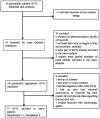The efficacy and safety of linezolid and glycopeptides in the treatment of Staphylococcus aureus infections
- PMID: 23484002
- PMCID: PMC3590119
- DOI: 10.1371/journal.pone.0058240
The efficacy and safety of linezolid and glycopeptides in the treatment of Staphylococcus aureus infections
Abstract
To assess the effectiveness and safety of linezolid in comparison with glycopeptides (vancomycin and teicoplanin) for the treatment of Staphylococcus aureus infections, we conducted a meta-analysis of relevant randomized controlled trials. A thorough search of Pubmed and other databases was performed. Thirteen trials on 3863 clinically assessed patients were included. Linezolid was slightly more effective than glycopeptides in the intent-to-treat population (odds ratio [OR], 1.05; 95% confidence interval [CI], 1.01-1.10), was more effective in clinically assessed patients (OR 95% CI: 1.38, 1.17-1.64) and in all microbiologically assessed patients (OR 95% CI: 1.38, 1.15-1.65). Linezolid was associated with better treatment in skin and soft-tissue infections (SSTIs) patients (OR 95% CI: 1.61, 1.22-2.12), but not in bacteraemia (OR 95% CI: 1.24, 0.78-1.97) or pneumonia (OR 95% CI: 1.25, 0.97-1.60) patients. No difference of mortality between linezolid and glycopeptides was seen in the pooled trials (OR 95% CI: 0.98, 0.83-1.15). While linezolid was associated with more haematological (OR 95% CI: 2.23, 1.07-4.65) and gastrointestinal events (OR 95% CI: 2.34, 1.53-3.59), a significantly fewer events of skin adverse effects (OR 95% CI: 0.27, 0.16-0.46) and nephrotoxicity (OR 95% CI: 0.45, 0.28-0.72) were recorded in linezolid. Based on the analysis of the pooled data of randomized control trials, linezolid should be a better choice for treatment of patients with S. aureus infections, especially in SSTIs patients than glycopeptides. However, when physicians choose to use linezolid, risk of haematological and gastrointestinal events should be taken into account according to the characteristics of the specific patient populations.
Conflict of interest statement
Figures







Similar articles
-
Linezolid versus vancomycin for Staphylococcus aureus bacteraemia: pooled analysis of randomized studies.J Antimicrob Chemother. 2005 Nov;56(5):923-9. doi: 10.1093/jac/dki355. Epub 2005 Sep 29. J Antimicrob Chemother. 2005. PMID: 16195255
-
Linezolid versus vancomycin for the treatment of gram-positive bacterial infections: meta-analysis of randomised controlled trials.Int J Antimicrob Agents. 2010 Jan;35(1):3-12. doi: 10.1016/j.ijantimicag.2009.09.013. Epub 2009 Nov 8. Int J Antimicrob Agents. 2010. PMID: 19900794 Review.
-
Linezolid for the treatment of methicillin-resistant Staphylococcus aureus infections in children.Pediatr Infect Dis J. 2003 Sep;22(9 Suppl):S178-85. doi: 10.1097/01.inf.0000087020.75886.93. Pediatr Infect Dis J. 2003. PMID: 14520144 Clinical Trial.
-
In vitro and in vivo activities of linezolid alone and combined with vancomycin and imipenem against Staphylococcus aureus with reduced susceptibility to glycopeptides.Eur J Clin Microbiol Infect Dis. 2010 Nov;29(11):1361-7. doi: 10.1007/s10096-010-1007-y. Epub 2010 Aug 1. Eur J Clin Microbiol Infect Dis. 2010. PMID: 20680368 Free PMC article.
-
Benefit-risk assessment of linezolid for serious gram-positive bacterial infections.Drug Saf. 2008;31(9):753-68. doi: 10.2165/00002018-200831090-00004. Drug Saf. 2008. PMID: 18707190 Review.
Cited by
-
Pharmacokinetics and pharmacodynamics of linezolid in plasma/cerebrospinal fluid in patients with cerebral hemorrhage after lateral ventricular drainage by Monte Carlo simulation.Drug Des Devel Ther. 2018 Jun 11;12:1679-1684. doi: 10.2147/DDDT.S168757. eCollection 2018. Drug Des Devel Ther. 2018. PMID: 29928111 Free PMC article.
-
Pharmacokinetics of linezolid in plasma and cerebrospinal fluid in patients with cerebral hemorrhage post-surgical intervention.Eur J Clin Pharmacol. 2017 Jul;73(7):919-921. doi: 10.1007/s00228-017-2239-x. Epub 2017 Mar 24. Eur J Clin Pharmacol. 2017. PMID: 28342065 No abstract available.
-
Prolonged infusion of linezolid is associated with improved pharmacokinetic/pharmacodynamic (PK/PD) profiles in patients with external ventricular drains.Eur J Clin Pharmacol. 2021 Jan;77(1):79-86. doi: 10.1007/s00228-020-02978-x. Epub 2020 Aug 18. Eur J Clin Pharmacol. 2021. PMID: 32812063 Clinical Trial.
-
Methicillin-resistant Staphylococcus aureus nosocomial pneumonia: role of linezolid in the People's Republic of China.Clinicoecon Outcomes Res. 2016 Mar 24;8:63-72. doi: 10.2147/CEOR.S91985. eCollection 2016. Clinicoecon Outcomes Res. 2016. PMID: 27069370 Free PMC article. Review.
-
The Risk and Clinical Implications of Antibiotic-Associated Acute Kidney Injury: A Review of the Clinical Data for Agents with Signals from the Food and Drug Administration's Adverse Event Reporting System (FAERS) Database.Antibiotics (Basel). 2022 Oct 6;11(10):1367. doi: 10.3390/antibiotics11101367. Antibiotics (Basel). 2022. PMID: 36290024 Free PMC article. Review.
References
-
- Herold BC, Immergluck LC, Maranan MC, Lauderdale DS, Gaskin RE, et al. (1998) Community- acquired methicillin-resistant Staphylococcus aureus in children with no identified predisposing risk. JAMA 279: 593–598. - PubMed
-
- Vardakas KZ, Matthaiou DK, Falagas ME (2009) Incidence, characteristics and outcomes of patients with severe community acquired-MRSA pneumonia. Eur Respir J 34: 1148–1158. - PubMed
-
- Cosgrove SE, Sakoulas G, Perencevich EN, Schwaber MJ, Karchmer AW, et al. (2003) Comparison of mortality associated with methicillin-resistant and methicillin-susceptible Staphylococcus aureus bacteremia: a meta-analysis. Clin Infect Dis 36: 53–59. - PubMed
-
- Moet GJ, Jones RN, Biedenbach DJ, Stilwell MG, Fritsche TR (2007) Contemporary causes of skin and soft tissue infections in North America, Latin America, and Europe: report from the SENTRY Antimicrobial Surveillance Program (1998–2004). Diagn Microbiol Infect Dis 57: 7–13. - PubMed
Publication types
MeSH terms
Substances
LinkOut - more resources
Full Text Sources
Other Literature Sources
Medical

